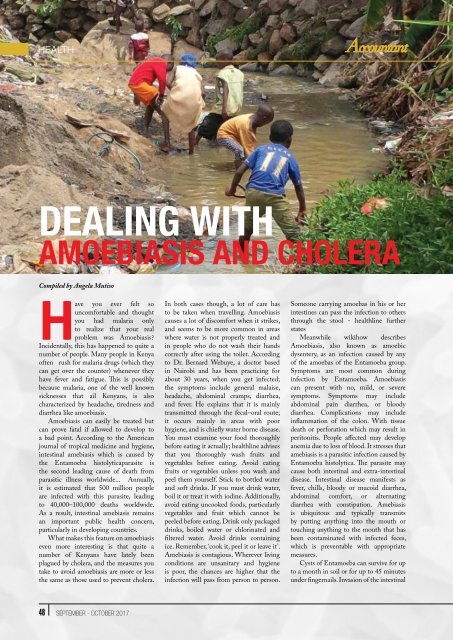The-Accountant-Sep-Oct-2017-Final
You also want an ePaper? Increase the reach of your titles
YUMPU automatically turns print PDFs into web optimized ePapers that Google loves.
HEALTH<br />
DEALING WITH<br />
AMOEBIASIS AND CHOLERA<br />
Compiled by Angela Mutiso<br />
Have you ever felt so<br />
uncomfortable and thought<br />
you had malaria only<br />
to realize that your real<br />
problem was Amoebiasis?<br />
Incidentally, this has happened to quite a<br />
number of people. Many people in Kenya<br />
often rush for malaria drugs (which they<br />
can get over the counter) whenever they<br />
have fever and fatigue. This is possibly<br />
because malaria, one of the well known<br />
sicknesses that ail Kenyans, is also<br />
characterized by headache, tiredness and<br />
diarrhea like amoebiasis.<br />
Amoebiasis can easily be treated but<br />
can prove fatal if allowed to develop to<br />
a bad point. According to the American<br />
journal of tropical medicine and hygiene,<br />
intestinal amebiasis which is caused by<br />
the Entamoeba histolyticaparasite is<br />
the second leading cause of death from<br />
parasitic illness worldwide... Annually,<br />
it is estimated that 500 million people<br />
are infected with this parasite, leading<br />
to 40,000–100,000 deaths worldwide.<br />
As a result, intestinal amebiasis remains<br />
an important public health concern,<br />
particularly in developing countries.<br />
What makes this feature on amoebiasis<br />
even more interesting is that quite a<br />
number of Kenyans have lately been<br />
plagued by cholera, and the measures you<br />
take to avoid amoebiasis are more or less<br />
the same as those used to prevent cholera.<br />
In both cases though, a lot of care has<br />
to be taken when travelling. Amoebiasis<br />
causes a lot of discomfort when it strikes,<br />
and seems to be more common in areas<br />
where water is not properly treated and<br />
in people who do not wash their hands<br />
correctly after using the toilet. According<br />
to Dr. Bernard Webuye, a doctor based<br />
in Nairobi and has been practicing for<br />
about 30 years, when you get infected;<br />
the symptoms include general malaise,<br />
headache, abdominal cramps, diarrhea,<br />
and fever. He explains that it is mainly<br />
transmitted through the fecal–oral route;<br />
it occurs mainly in areas with poor<br />
hygiene, and is chiefly water borne disease.<br />
You must examine your food thoroughly<br />
before eating it actually; healthline advises<br />
that you thoroughly wash fruits and<br />
vegetables before eating. Avoid eating<br />
fruits or vegetables unless you wash and<br />
peel them yourself. Stick to bottled water<br />
and soft drinks. If you must drink water,<br />
boil it or treat it with iodine. Additionally,<br />
avoid eating uncooked foods, particularly<br />
vegetables and fruit which cannot be<br />
peeled before eating. Drink only packaged<br />
drinks, boiled water or chlorinated and<br />
filtered water. Avoid drinks containing<br />
ice. Remember, ‘cook it, peel it or leave it’.<br />
Amebiasis is contagious. Wherever living<br />
conditions are unsanitary and hygiene<br />
is poor, the chances are higher that the<br />
infection will pass from person to person.<br />
Someone carrying amoebas in his or her<br />
intestines can pass the infection to others<br />
through the stool - healthline further<br />
states<br />
Meanwhile wikihow describes<br />
Amoebiasis, also known as amoebic<br />
dysentery, as an infection caused by any<br />
of the amoebas of the Entamoeba group.<br />
Symptoms are most common during<br />
infection by Entamoeba. Amoebiasis<br />
can present with no, mild, or severe<br />
symptoms. Symptoms may include<br />
abdominal pain diarrhea, or bloody<br />
diarrhea. Complications may include<br />
inflammation of the colon. With tissue<br />
death or perforation which may result in<br />
peritonitis. People affected may develop<br />
anemia due to loss of blood. It stresses that<br />
amebiasis is a parasitic infection caused by<br />
Entamoeba histolytica. <strong>The</strong> parasite may<br />
cause both intestinal and extra-intestinal<br />
disease. Intestinal disease manifests as<br />
fever, chills, bloody or mucoid diarrhea,<br />
abdominal comfort, or alternating<br />
diarrhea with constipation. Amebiasis<br />
is ubiquitous and typically transmits<br />
by putting anything into the mouth or<br />
touching anything to the mouth that has<br />
been contaminated with infected feces,<br />
which is preventable with appropriate<br />
measures.<br />
Cysts of Entamoeba can survive for up<br />
to a month in soil or for up to 45 minutes<br />
under fingernails. Invasion of the intestinal<br />
48 september - october <strong>2017</strong>

















